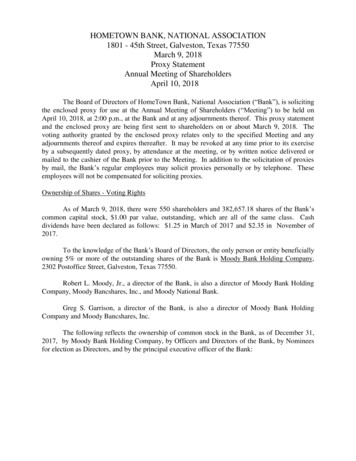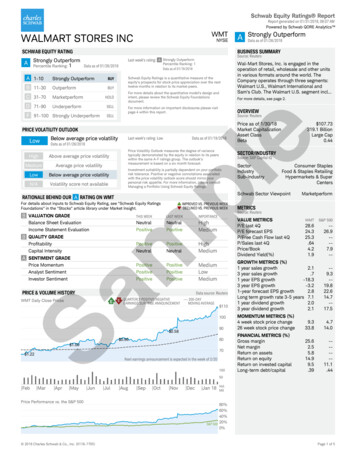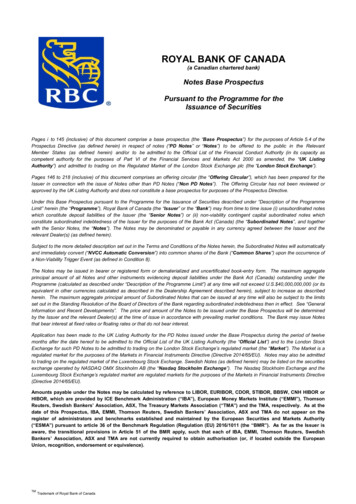
Transcription
Market Implied Ratings FAQUpdated: June 2010
1.What are MIR (Market Implied Ratings)?Moody’s Analytics Market Implied Ratings translate prices from the CDS, bond and equity markets into standard Moody’s ratingslanguage. Market Implied Ratings are available on both an issuer-lever and security-level basis. An implied rating is calculated bycomparing an entity or security’s trading price to the trading prices of all other entities or securities in the same Moody’s ratingcategory.2. Who produces Market Implied Ratings?Market Implied Ratings are produced by Moody’s Analytics Capital Markets Research Group (CMRG). The Capital Markets ResearchGroup’s research focuses on explaining signals from the credit and equity markets. It addresses whether market signals, in theopinion of the group’s analysts, accurately reflect the risks and investment opportunities associated with issuers and sectors. CRMGresearch thus complements the fundamentally-oriented research offered by Moody’s Investors Service (MIS), the rating agency. Formore information on Moody’s Analytics Capital Market Research Group, please refer to the Capital Markets Research Group FAQ.3. How does Moody's Analytics calculate bond-implied ratings?1.2.3.A daily “pricing grid” is derived from bond market data, relating median spread-over-treasury to bond duration for every ratingcategory.A market implied gap (relative to Moody’s ratings) is inferred for each bond in the sample from the pricing grid.An issuer’s bond-implied rating is the average rating gap across its bonds added to its Moody’s senior rating.Important points about this methodology: The sample includes all bonds of issuers rated by Moody’s with a duration of over a year, face value of over 100 million,and denominated in U.S. dollars, Euros, British Pounds, Australian Dollars, Canadian Dollars, Swiss Francs or Japanese Yen.Further, included bonds cannot be guaranteed outside the corporate family, or be in default. If a bond is guaranteed withinthe corporate family, it is reassigned to the guarantor and only used if the guarantor does not have rated debt of its own.For bonds subject to put or call options, Moody's uses option adjusted spreads and option adjusted duration as the inputs.If an issuer has straight bonds, though, its bonds with options are excluded.The model is designed to eliminate systematic variations in the aggregate price of risk in order to reflect differencesattributable to company-specific factors.4. How does Moody's Analytics calculate credit default swap-implied ratings?1.2.3.A daily "pricing grid" is derived from the midpoints of bid/ask spreads on daily five-year credit default swap quotes for everyrating category.A market implied gap (relative to Moody's ratings) is inferred for each credit default swap in the sample from the pricing grid.An issuer's CDS-implied rating is the average rating gap across CDS quotes added to its Moody's senior rating.Important points about this methodology:
5.Within the investment grade universe, the market data is sufficient to estimate median credit default swap spreads byrating category.However, within the speculative grade universe, the market data is not sufficient to estimate median credit default swapspreads by rating category. However, a theoretical link to bond pricing provides a method for Moody’s Analytics toconstruct an implied credit default swap pricing grid for speculative grade issuers. For the implied credit default swappricing grid, Moody’s Analytics assumes that the credit default swap spread is approximately equal to the bond yield lessthe interest rate swap rate.How does Moody’s Analytics calculate equity-implied ratings?An equity-implied rating is the credit category assigned to a firm based on its Expected Default Frequency. The equity-implied ratingsavailable through Market Implied Ratings are based on Moody's Analytics EDF (Expected Default Frequency) credit measures. Themapping from EDF measures to implied ratings is determined by median EDF measures of firms in ratings classes using Moody'sAnalytics "spot median" methodology.Note that the "spot median" for a major rating class captures the median of the most recent month's EDF values for all NorthAmerican non-financial firms that fall into a specified rating class.6. What is Moody's Analytics EDF credit measure?Moody's Analytics EDF credit measures are advanced default probabilities for public and private companies. Built on over 15 years ofexperience with market/fundamental data and modeling, EDF credit measures have been extensively validated on defaults and creditspreads and are the market standard for lenders and investors.Public company EDF credit measures are based on collective, real-time intelligence from global markets. A public firm's probability ofdefault is essentially calculated on three main factors: the market value of its assets, its volatility and its current capital structure. TheEDF credit measure captures the value of the firm from the equity market and combines it with a detailed picture of each company'scapital structure. To learn more about EDF credit measures, visit www.moodyskmv.com or call your Moody’s Analytics salesrepresentative.7.What sources does Moody's Analytics use for the underlying bond pricing?Moody's Analytics sources bond market prices for its bond-implied ratings from industry leading third-party vendors and marketassociations. These vendors evaluate the information collected with their proprietary models before distributing the data.8. What sources does Moody's Analytics use for the underlying credit default swap pricing?Moody's Analytics sources credit default swap prices for its credit default swap-implied ratings from Mark-it Partners.
9. Does Moody's Analytics provide access to the underlying pricing data?Moody's Analytics is currently not licensed to redistribute the pricing data it receives from third-party vendors.10. How much of a gap between a market implied rating and a Moody's rating should be considered significant?For bond-implied ratings and credit default swap-implied ratings, gaps and movements of one or two notches are generally notsignificant for several reasons. First, one notch differences are often attributable to "rounding error." At some point, a cutoff must bemade for what constitutes, for instance, an A2 credit. For credits close to this cutoff, small fluctuations in market pricing could drivethe market implied rating in line with Moody's rating one day and away from it the next.Second, the spreads used to infer bond-implied ratings or credit default swap-implied ratings may be influenced by non-creditfactors, such as liquidity risk.Third, in many cases, credit spreads and credit default swap spreads are representative indicative quotes that may be an imperfectindicator of a security's likely trading price.Finally, a rating differential may be material at some rating levels, but not at others. For example, for firms with very low ratings(whose default risk is highest), such as Caa, ratings gaps are truncated due to the lower limit of the ratings scale.The following graph depicts the historical distribution of ratings gaps for bond-implied ratings from 2001 to 2010:Bond- Implied Ratings Gap Distributions forCorporates and Financial Institutions24%24%Corporates20%20%Financial Institutions16%16%12%12%8%8%4%4%0%0% 86420-2-4-6 -8
11. Why are credit default swap-implied ratings different from bond-implied ratings?The credit default swap spread is approximately equal to the bond yield less the interest rate swap rate (where the interest rate swaprate is equal to the swap rate less the treasury rate). The equivalence can be understood using the following arbitrage strategy: Borrow money at LIBOR;Use and interest rate swap to convert the floating LIBOR rate to a fixed rate;Buy the corporate bond; andBuy the credit default swap (a five-year contract).Since the credit risk of the corporate bond is hedged, you make money when the bond yield is greater than the sum of the creditdefault swap price and the swap rate. If the opposite is true, then you could make money by shorting the bond, selling the creditdefault swap and lending money at the swap rate.However, this arbitrage is inexact for a number of reasons, including: Few issuers have corporate bonds with five years remaining maturity, while most credit default swaps are five-yearcontracts.The definition of default in credit default swap contracts differs from that in bond default events.Buyers of credit default swaps have an option as to which of the corporations issues to deliver after a default event and willselect so as to maximize settlement profit.Models often predict "negative" credit default swap prices for the strongest credits.Taxes differ for the "funded" and "unfunded" strategies.Counterparty risk exists in swaps and credit default contracts.Any one of these potential factors could cause a difference between the bond-implied rating and the credit default swap-impliedrating.12. Do Moody's ratings analysts use market implied ratings as an input in their analysis?Moody's ratings analysts use market implied ratings to identify material and systematic gaps between Moody’s ratings and theratings implied by market data. They use them to compare their opinions to those held by the broader market or those generated bypurely quantitative models, so that they are prepared to clearly articulate the reasons for any differences to market participants.Market implied ratings are not, however, an "input" into their rating decisions.13. Does Moody's Analytics’ publication of market implied ratings indicate an initiative to move Moody’s ratings more in-linewith market ratings over time?The initiative is to provide a freer flow of information, transparency, and utility to the market, not to force consensus betweenMoody’s rating opinions and market-based measures. Market-based measures are inherently volatile and produce many falsepositives and false negatives. Moody’s remains committed to producing opinions that look beyond each day's news to provide muchmore stable, although equally predictive, measures of long-term credit risk.
For instance, about 90% of bond-implied ratings change each year. Furthermore, when there is a difference between Moody’s ratingand the bond-implied rating:1.2.The Moody's rating changes, and the change is toward the bond-implied rating about 80% of the time, and further away about20% of the time. Most of the instances when the Moody's rating moves toward the bond-implied rating are preceded by formaloutlook designations or rating reviews in the same direction.The bond-implied rating subsequently changes, the change is toward the Moody's rating about 60% of the time and furtheraway about 40% of the time.14. Where can I find a mapping from Moody's Analytics EDF credit measures to Moody's credit rating categories?Moody's Analytics CreditEdge clients can find a current mapping at www.creditedge.com/mkmv. If you are not currently aCreditEdge client and would like more information, please go to www.creditedge.com/contact.html.15. What is a Moody's Rating Outlook?A Moody's Rating Outlook is an opinion regarding the likely direction of a rating over the medium term. Where assigned, RatingOutlooks fall into the following four categories: Positive (POS), Negative (NEG), Stable (STA), and Developing (DEV contingent uponan event). In the few instances where an issuer has multiple Outlooks of differing directions, an (m) modifier (indicating multiple,differing Outlooks) will be displayed. In these cases, Moody's written research will describe any differences and provide the rationalefor the differences. An RUR (Rating(s) Under Review) designation indicates that the issuer has one or more ratings under review forpossible change, and thus overrides the Outlook designation. When an Outlook has not been assigned to an eligible entity, NOO(No Outlook) may be displayed. Finally, a double-dash ("--") indicates that Moody's does not have that particular Outlook dataavailable in a digital format.16. How does Moody's Analytics calculate Median Credit Spreads?The process involves creating a series of medians by duration for each broad Moody’s rating category, and then using statisticaltechniques to fit a smooth curve through the medians. Each curve therefore represents the typical spread that a bond with a givenduration in a given broad rating category will have. Cutoffs between the rating categories are created based on these curves suchthat the logarithms of the cutoffs between any two median curves are equally spaced.17. What is the difference between Historical Time Series and Snapshot views in Moody's Analytics Median Credit Spreads?Historical Time Series view shows the historical median credit spreads for a specific duration or maturity. Snapshot view shows thecurves across all durations/maturities for a given point in time.
18. How does Moody's Analytics calculate "Simple Weighted Average" market implied ratings?Simple Weighted Averages are calculated for Moody's Senior Unsecured or Equivalent Rating, and each "column" of implied gaps(e.g., average bond-implied gap, average CDS-implied gap) in a user's portfolio. Following are the key steps:1.Calculate the simple weighted average rating for the Moody's Senior Unsecured or Equivalent Rating. Each credit rating has anumeric ranking assigned to it (e.g., Aaa 1; Aa1 2; Aa2 3; etc.) which is used as a proxy for the average rating in thecalculation.Simple Weighted Average Rating Σ (Weight*Rating) / Σ (Weight)2.Calculate the simple weighted average "gap":Simple Weighted Average Gap Σ (Weight*Gap) / Σ (Weight)Note that this calculation includes only issuers with current MIR data. While the calculation defaults to equal weight for eachportfolio, users may change the weights to suit their preferences.19. How does Moody's Analytics calculate "Default Probability Weighted Average" market implied ratings?Default Probability Weighted Averages are calculated for each "column" of implied ratings data (e.g., average bond-implied rating,average CDS-implied rating) in a user’s portfolio. Each credit rating has a numeric ranking assigned to it (e.g., Aaa 1; Aa1 2; Aa2 3; etc.) which is used as a proxy for the rating in the calculation. Following are the key steps:1.Calculate the default probability-weighted average rating for the Moody's Senior Unsecured or Equivalent Rating. Each creditrating has a numeric ranking assigned to it (e.g., Aaa 1; Aa1 2; Aa2 3; etc.) which is used as a proxy for the average rating inthe calculation.DP Weighted Average Rating Σ (DP*Weight*Rating) / Σ (DP*Weight)2.Calculate the default probability weighted average "gap":DP Weighted Average Gap Σ (DP*Weight*Gap) / Σ (DP*Weight)Note that this calculation includes only issuers with current MIR data. While the calculation defaults to equal weight for eachportfolio, users may change the weights to suit their preferences.20. What are Market Implied Ratings Transition Matrices, and how are they calculated?The salient features of the methodology for MIR transition matrices are as follows:Cohorts of issuers are constructed according to initial "ratings gaps." Specifically, each cohort covers a 12-month period and includesall issuers that have the same ratings gap at the beginning of the period. The Moody's ratings and implied ratings of each issuer in thecohort are recorded in the first and last months, ignoring any variations during the interim period. The transition probabilities forboth Moody's ratings and Market Implied Ratings are estimated as the proportion of issuers at the end of the sampling period againstthe total number of starting observations in a given category.
For example, let's say that there are 100 issuers starting out with a Moody's rating of Baa3. If we observe 20 issuers ending with Ba1,we say that the empirical probability of issuers moving from Baa3 to Ba1 in 12 months is 20%. We reconstruct the cohorts in thenext month, and re compute the transition probabilities using the same method described above. In other words, we create a 12month cohort that rolls over every month.Suppose the analysis uses monthly rating data from January 1999 to February 2006. The initial sampling month starts in January1999, and the last sampling month starts in March 2005. A total of 74 transition matrices result. The summary 12-month transitionmatrix is derived from:1.2.the aggregation of the counts of the 74 transition matrices, andcomputation of the migration frequencies of a given category (by row) as the counts at the ending period (by column) dividedby the total number in that category.21. Are the Market Implied Ratings median credit spreads the same as those provided in Credit Trends?No, the Market Implied Ratings median credit spreads are different from those provided as part of Credit Trends Yields and Spreads.Market Implied Ratings provides median credit spreads by rating category and maturity / duration, and have a history dating backseveral years. MIR’s median credit spreads are updated daily, and are used to calculate market implied ratings. Credit Trendsprovides median yields for seven-year bonds by rating category; they are calculated at the end of every month, and have a historydating back to 1991.
the interest rate swap rate. 5. How does Moody's Analytics calculate equity-implied ratings? An equity-implied rating is the credit category assigned to a firm based on its Expected Default Frequency. The equity-implied ratings available through Market Implied Ratings are based on Moody's Analytics EDF (Expected Default Frequency) credit .










